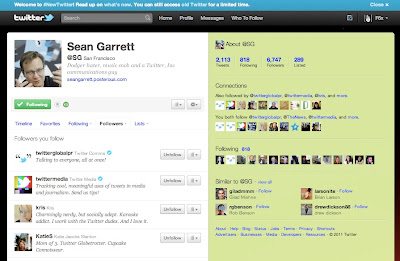 |
| Connecting to Twitter Communications. |
Did you notice a change on your favorite Twitterer’s home page today? Initially, I didn’t (because I use
Brizzly,
most of the time), but I did get a
heads-up from The Next Web.
The new feature helps put any user into greater context for you. By adding a little insight into common connections, you get a better perspective of any interests you may share. But
Connections doesn’t yet go far enough. Maybe this is the first step to a followers recommendation engine?
Before we go on, let’s clarify one important thing:
Connections does not show you users who are following you both. That notification only comes when you get the e-mail from Twitter alerting you to a new follower. Let’s look at an example:
Because I want to work on his team, I am following
Sean Garret. When I visit his Twitter profile page, I know he has
6,747 followers (and counting), and is
following 818. But the only way for me to know which accounts he follows who are following me is in the notification I get when Mr. Garrett follows me. Which he doesn’t. So I don’t know.
As I understand the new system, “Also followed by” is a list of the people who show up on both of your “Following” lists. Continuing with the Sean Garrett profile, of the 818 accounts he follows, I’m only following 15. Those 15 show up in the “Also followed by” list. I follow
Twitter Comms. He follows Twitter Comms. Twitter Comms is not following me. But they are on the “Also followed by” list because I follow Twitter Comms and he follows Twitter Comms.
 |
| Also followed by. |
“You both follow” is a list of people in their “Followers” list who you are following. As I mentioned, Sean Garrett has 6,747 followers. But of those 6,747 followers, I’m only following 15. Again, Twitter Comms is following him. I am following him. Twitter Comms is not following me. But they are on the “You both follow” list because I follow Twitter Comms and Twitter Comms follows him.
 |
| You both follow. |
It’s a delicate distinction, I know, but an important one. Twitter’s site does not yet have a way of showing me that Mr. Garret is following someone who is following me but who I am not following back.
 |
I’m missing something.
(Image thanks to @teleject.) |
At this point, the information provided is only a little enlightening. Sure, you can see which accounts you are both following, and which accounts you follow that are also following them. But I want to know more. I want to learn about another user who is already vetted by someone I trust. What we need is a way to discover a user who is following us, but we’re not following back yet, even though someone we trust is following us both. If Twitter wants to help us find interesting, informative new accounts to follow, we need an easier way to find out from our curated sources who trusts us, and rely on those connections to expand our own trusted authorities.
This update comes at a great time for me, however. I think I’m
building an application that will use this new addition to put Twitter’s information engine to greater use for finding out what’s important to you. I’m making steady progress in learning the Twitter API, and have a few ideas on how to build my first application. With this new addition, I might not have to create as much of this code on my own—which is good, because I still have a lot to learn when it comes to coding. But I can tell you more about that when I see you on the ‘morrow, on the Web.























